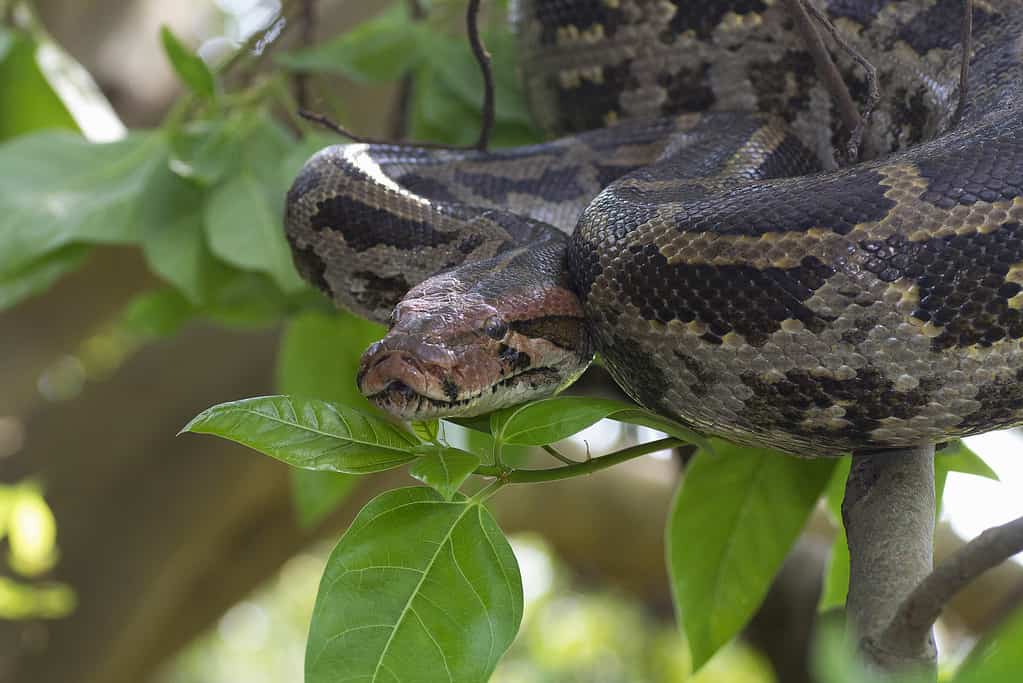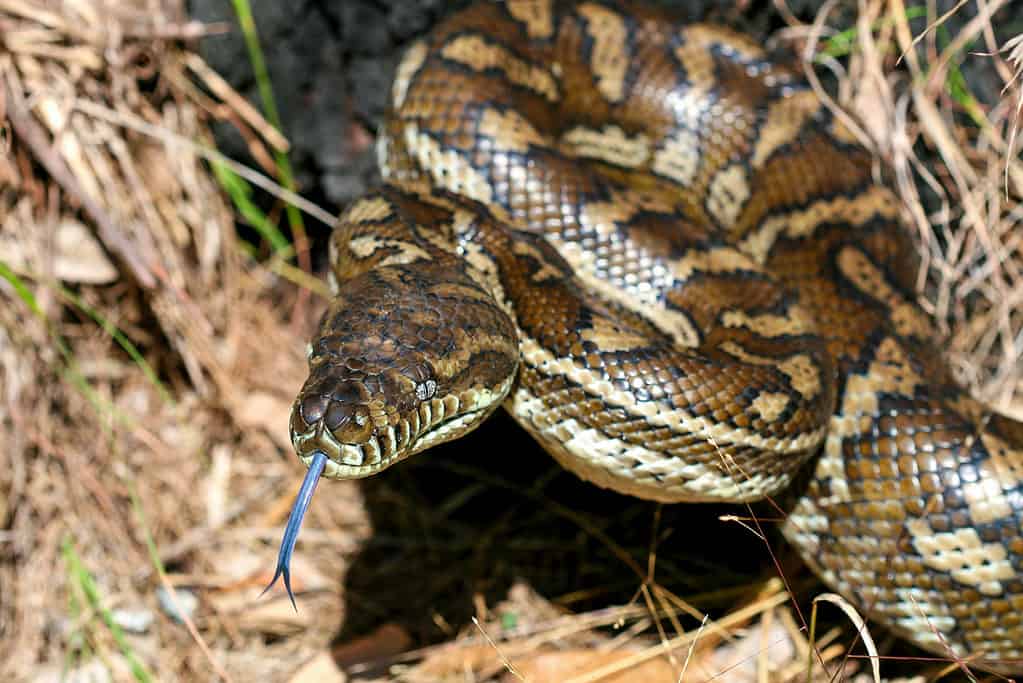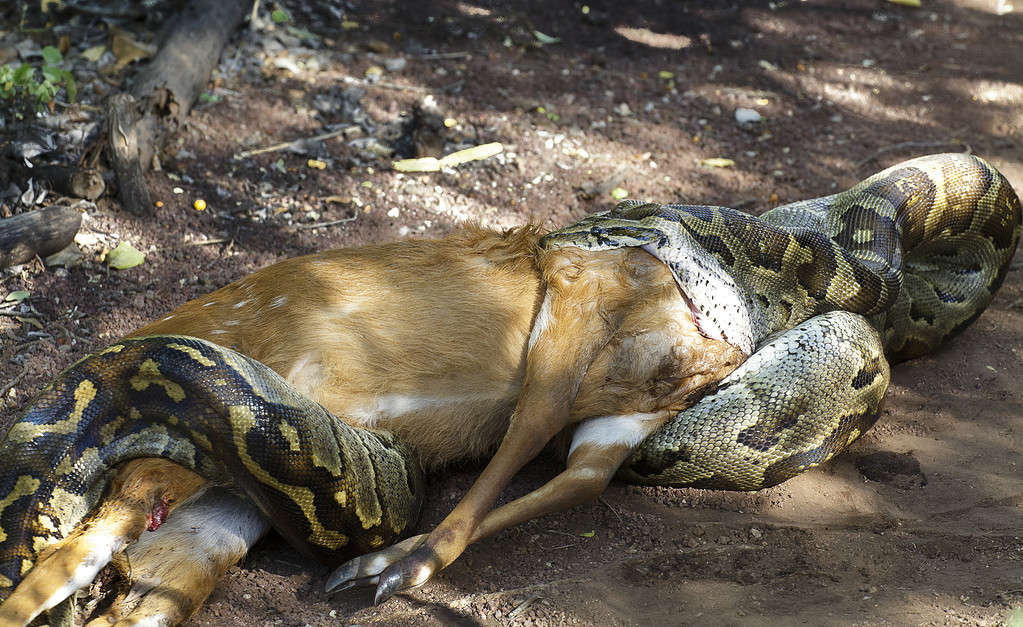Perhaps one of the more well-known snakes is the mighty python. Often depicted as villains or evil beings in films, this large snake appears terrifying to most. While it is nonvenomous, it has no shortage of offensive capabilities. Between their sharp teeth and ability to squeeze their prey until their heart stops, there is no question why they are a fearsome predator. One thing that most people may not think about when thinking of pythons is their feces. However, snake feces can tell an interesting story. This article will dive into all things python poop and covers everything you have ever wanted to know about it.
What Does Python Poop Look Like?

Python’s poop may be larger and have more liquid than other snake’s poop due to their large size and larger prey size.
©ePhotocorp/iStock via Getty Images
Python poop is similar to many other animals’ poop in the sense that it has a foul odor and is usually brown in appearance. Snake poop has an oblong shape and usually liquid excretion with the feces. Snake feces may also often have remnants of their last meal in their poop, such as hair, bones, or scales.
A healthy snake’s poop will be brown and have a log shape. It will have some liquid urine and some mucous. Additionally, it will have some remnants of its last meal. It could also have a chalky white substance known as urates. Unhealthy snake poop could appear in any of the following colors: green, yellow, or red.
How Do Pythons Poop?
If this is not the first question that comes to mind when looking at a python, I doubt you are alone. However, understanding how pythons and snakes generally excrete waste is far more complex than just their feces. Understanding how the python excretes waste also gives us an inside look at how they consume and digest their food. Similarly to other animals, snakes digestion process works in the same way. Once everything has been completely digested, it exits their body. For snakes, it exits their body near a small opening near the end of their tail. Snakes defecate, urinate, lay eggs, and mate through the same opening.
The snake’s body is composed of four quadrants, and the food and waste pass through each quadrant during the digestive process. A snake’s diet is directly related to how they poop. For example, a larger snake — like the python — eats larger prey. The larger the prey, the less frequently that snake needs to eat. That means that the python may have a large bowel movement but then will not need to go again for an extended period of time until their next meal.
How Often Do Pythons Poop?

Pythons squeeze prey to stop their hearts.
©Michelle Marks/Shutterstock.com
Similar to humans, pythons will poop after their meal is fully digested. However, a python eats and goes to the bathroom much less than a person would. While a person may go every day or several times a week, a python goes far less frequently. On average, pythons will poop about one week after consuming their meal. Due to their larger prey, an adult python only needs to eat one to two times a week. After the meal is consumed, the python excretes the waste in six to eight days. So a healthy python should poop about once a week. Although it seems like a very lengthy process, snake digestion works in really neat ways. The majority of their consumed food, about 91%, gets reabsorbed back into their bodies, leaving very little to be excreted as waste.
Does Python Poop Smell?
Like most other feces in the animal kingdom, the poop of a snake is no exception in the smell category. Yes, snake poop does smell. Snakes often have a high-protein diet, which tends to lead to a stronger odor of feces than that of an herbivore. Unfortunately for python owners, the more poop there is, the more smell it emits. Due to the python’s larger size, the amount of poop and smell would be greater than that of a smaller snake.
Additionally, if the snake is stressed or feels threatened, it can release a musk which can be confused with poop. Similarly to feces, the musk is excreted through the cloaca or the opening near the end of the snake’s tail. The musk is an oily white substance with a rotten egg or dead fish smell. This secretion is far more potent than the python’s feces.
What Do Pythons Eat?

Pythons can consume prey much larger than them. The African rock python often eats antelopes.
©JedsPics_com/iStock via Getty Images
These carnivorous reptiles are well known and often feared due to their large size and squeezing capabilities. As one of the largest snakes in the world, people often wonder what these massive reptiles eat. The majority of the python’s diet is lizards. Pythons eat vertebrates such as lizards and snakes. However, as the pythons grow and get bigger, their diet can also begin to include small mammals. Here are some animals that make it on the python’s dinner menu.
- Possums
- Monkeys
- Turtles
- Antelope
- Leopards (yes, even leopards!)
The type and size of prey depend on the python that is consuming it. For example, Burmese pythons eat small leopards, and African rock pythons eat antelopes.
Is Python Poop Harmful?
Besides harming your sense of smell with its foul odor, another risk comes from python poop; the risk of salmonella. Snake fecal matter contains bacteria that can lead to salmonella, which can cause a person to get very sick. Salmonella has been linked to health complications with joints, bones, blood, and the nervous system.
If you do come into contact with snake feces, you should be sure to dispose of it properly. Be sure to wear plastic gloves and an air mask to protect yourself from harmful bacteria. Salmonella symptoms usually appear between six hours and six days after an infection and are often confused with the stomach flu. If you have been handling snake feces and begin to have symptoms, it is best to contact your healthcare provider.
Uses of Python Poop
Although it is strange to think that feces serve another purpose besides just ridding the body of waste products, python poop does have another function. Python poop is a great deterrent for certain rodents. People may use it around entrances where mice sneak in or on their roofs to prevent possums from climbing up there. The scent of a larger predator nearby scares these smaller rodents off.
However, if you choose to use this method to keep your home pest-free, be sure to keep the feces away from pets and children. As discussed above, snake poop has bacteria that can carry salmonella. Contracting salmonella can lead to a myriad of health issues. So when handling snake feces, be sure to take proper precautions with handling it and its placement to keep you and your family safe.
Do all Snakes Poop the Same?

All snakes are split into four quadrants for digestion.
©bugphai/iStock via Getty Images
While most snakes look different in their outward appearance, the same cannot be said for their poop. Snakes share the same basic digestion functions. The snake is split into four quadrants, which can be summarized as follows:
- Quadrant One: mouth, trachea, and esophagus
- Quadrant Two: esophagus, lung(s), and liver
- Quadrant Three: stomach
- Quadrant Four: small and large intestine and cloaca
Food travels from the mouth to the cloaca in all snakes, and the process of decomposing the food and absorbing the necessary minerals is the same. The difference is not in how snakes poop but what their poop looks like. The size and diet of the snake will affect what their feces look like. For example, due to pythons large size, their poop is usually larger and contains more urine than the poop of a smaller snake.
Python Facts
Here are five incredible facts about the python that have nothing to do with their poop.
- Ball pythons are the most popular pet snake.
- Pythons swallow their prey whole.
- Pythons are an invasive species in the United States.
- While most snakes only have one lung, pythons are among the few snakes with two.
- Pythons have remnants of hind legs and pelvic bones.
The photo featured at the top of this post is © fivespots/Shutterstock.com
Discover the "Monster" Snake 5X Bigger than an Anaconda
Every day A-Z Animals sends out some of the most incredible facts in the world from our free newsletter. Want to discover the 10 most beautiful snakes in the world, a "snake island" where you're never more than 3 feet from danger, or a "monster" snake 5X larger than an anaconda? Then sign up right now and you'll start receiving our daily newsletter absolutely free.
Thank you for reading! Have some feedback for us? Contact the AZ Animals editorial team.







